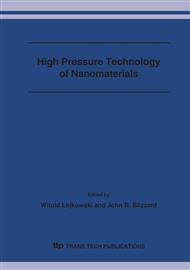[1]
V. M. Segal: Materials Science and Engineering, A197 (1995), p.157.
Google Scholar
[2]
R. Z. Valiev, R. K. Islamgaliev, I. V. Alexandrov: Progress in Materials Sciece, 45 (2000), p.103.
Google Scholar
[3]
N. Krasilnikov, W. Lojkowski, Z. Pakiela and R. Valiev: Solid State Phenomena, 94 (2003), p.51.
Google Scholar
[4]
V. V. Stolyarov, R. Lapovok, I. G. Brodova and P. F. Thomson: Materials Science and Engineering, A357 (2003), p.159.
Google Scholar
[5]
A. P. Zhilyaev, B. -K. Kim, J. A. Szpunar, M. D. Baro and T. G. Langdon: Materials Science and Engineering, A391 (2005), p.377.
Google Scholar
[6]
Yu. Ivanisenko, R. Z. Valiev and H. -J. Fecht: Materials Science and Engineering, A390 (2005), p.159.
Google Scholar
[7]
E. Schafler and R. Pippan: Materials Science and Engineering, A387-389 (2004), p.799.
Google Scholar
[8]
M. Lewandowska, H. Garbacz, W. Pachla, A. Mazur and K. J. Kurzydlowski: Solid State Phenomena, 101-102 (2005), p.65.
DOI: 10.4028/www.scientific.net/ssp.101-102.65
Google Scholar
[9]
M. Lewandowska, H. Garbacz, W. Pachla, A. Mazur and K. J. Kurzydlowski: Materials Science Poland, vol 23 No. 02 (2005), p.279.
Google Scholar
[10]
M. Kulczyk, W. Pachla, A. Mazur, R. Diduszko, H. Garbacz, M. Lewandowska, W. Lojkowski and K. J. Kurzydlowski: Materials Science Poland, Accepted (2005).
Google Scholar
[11]
N. Krasilnikov, W. Lojkowski, Z. Pakiela and R. Valiev: Materials Science and Engineering, A397 (2005), p.330.
Google Scholar
[12]
R. Z. Valiev, R. S. Mishral, J. Grozal and A. K. Mukherjee: Scripta Materialia, 34 (1996), p.1443.
DOI: 10.1016/1359-6462(95)00676-1
Google Scholar
[13]
R. Valiev: Nature, 3 (2004), p.511.
Google Scholar
[14]
K. J. Hemker and H. Last: Materials Science and Engineering, A319-321 (2001), p.882.
Google Scholar
[15]
T. E. Buchhein, D. A. Lavan, J. R. Michael, T. R. Christenson and S. D. Leith: Metall. and Mat. Trans., A, 32A (2002), p.539.
Google Scholar
[16]
A. Robertson, U. Erb and G. Palombo: Nanostructured Materials, 12 (1999), p.1035.
Google Scholar
[17]
D. J. Young: MRS Bulletin, April (2001), p.331.
Google Scholar
[18]
M. P. de Boer and T.M. Mayer: MRS Bullutin, April (2001), p.302.
Google Scholar
[19]
P. Coulomb, PWN, Warszawa, (1977).
Google Scholar
[20]
Y. Wang, M. Chen, F. Zhou and E. Ma: Nature, 419 (2002), p.912.
Google Scholar
[21]
H. Mughrabi, H. W. Höppel, M. Kautz and R. Z. Valiev: Z. Metallkunde, 94 (2003), p.1079.
Google Scholar
[22]
X. Zhang, et al.: Acta Mater., 50 (2002), p.4823.
Google Scholar
[23]
Y. S. Park, K. H. Chung, N. J. Kim and E. J. Lavernia: Materials Science and Engineering, A374 (2004), p.211.
Google Scholar
[24]
K. Neishi, Z. Horita and G. Langdon: Materials Science and Engineering, A325 (2002), p.54.
Google Scholar
[25]
L. E. Murr: Scripta Metall. 6 (1972) p.203.
Google Scholar
[26]
http: /www. MatWeb. com.
Google Scholar


